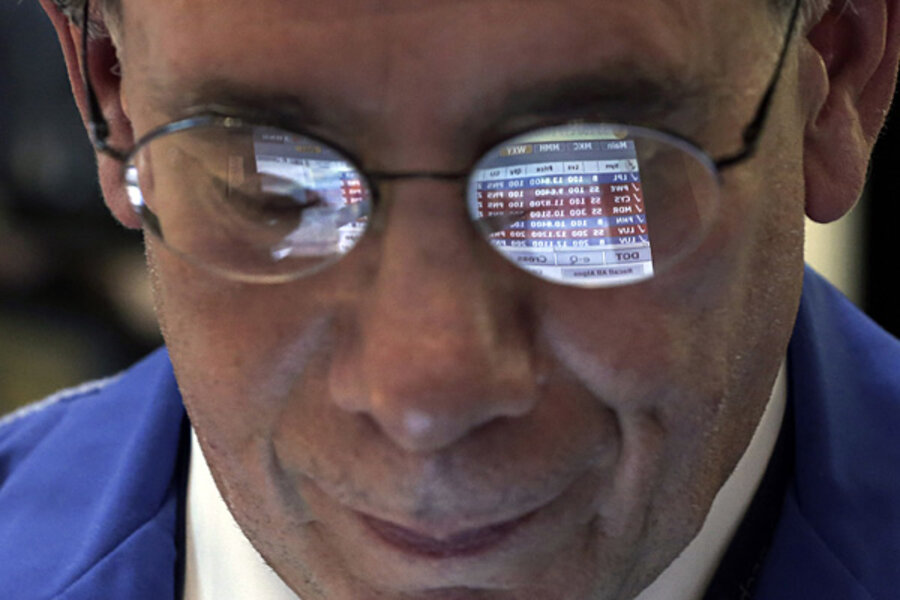Stocks rise on drop in unemployment
Loading...
The Dow pushed further into record territory Thursday, having surpassed its previous all-time high two days ago. The catalyst was the latest evidence that hiring is picking up.
Stocks started higher after the Labor Department reported that the number of Americans seeking unemployment aid fell by 7,000 last week, driving the four-week average to its lowest in five years. The drop is a positive sign ahead of Friday's employment report.
The Dow Jones industrial average rose 33.25 points, or 0.2 percent, to 14,329.49. The Standard & Poor's 500 gained 2.80 points, or 0.2 percent, to 1,544.26. Both indexes rose for the fifth day straight.
The Dow barreled through a record high Tuesday and has added to its gains since then. The S&P 500 is also closing in on its own record high of 1,565, which was also reached on Oct. 9, 2007, the same day of the Dow's previous peak. The S&P would need to rise 21 points, or 1.3 percent, to set a record.
Investors have been buying stocks on optimism that employers are slowly starting to hire again and that the housing market is recovering. Growing company earnings are also encouraging investors to get into the market. The Dow is 9.4 percent higher this year and the broader S&P 500 is up 8.3 percent.
"If you have a multi-year time horizon, equities are an attractive asset, but don't be surprised to see some volatility, especially after the big run we've had," said Michael Sheldon, chief market strategist at RDM Financial Group.
Boeing gained Thursday, advancing $1.97, or 2.5 percent, to $81.05 following reports that U.S. regulators were poised to approve a plan within days to allow the plane maker to begin test flights of its 787 Dreamliner. The 787 fleet has been grounded since Jan. 16 because of safety concerns about the plane's batteries. Twenty stocks in the 30-member index advanced.
The Federal Reserve will release the results of its annual stress test for banks after the market closes Thursday. Financial stocksadvanced amid speculation that banks will have amassed enough capital to be able to return more cash to shareholders. Bank of America had the largest percentage gain in the Dow, rising 34 cents, or 2.9 percent, to $12.26, with JPMorgan Chase in third spot, gaining 60 cents, or 1.2 percent, to $50.63.
Jeffery Saut, chief investment strategist at Raymond James, predicted that any sell-off in stocks may be short-lived as investors who have missed out on the rally since the start of the year jump into the market.
"The rally is going to go higher than most people think," Saut said. "This thing has caught most money managers flat-footed."
The stock market's rally this year has been helped in no small part by continuing economic stimulus from the Federal Reserve. The U.S. central bank began buying bonds in January 2009 and is still purchasing $85 billion each month in Treasury bonds and mortgage-backed securities. That has kept interest rates near historic lows, reducing borrowing costs and encouraging investors to move money out of conservative investments like bonds and into stocks.
The Nasdaq composite advanced 9.72 points, or 0.3 percent, to 3,232.09.
The yield on the 10-year Treasury note, which moves inversely to its price, rose to 2 percent from 1.94 percent.
Among stocks making big moves:
— PetSmart fell $4.37, or 6.6 percent, to $62.18 after the company reported its fiscal fourth-quarter earnings. Profits for the pet store chain rose but its forecast for this year disappointed investors.
— Pier 1 Imports fell 96 cents to $22.28 after the home decor company issued an earnings forecast that was below Wall Street analysts' estimates.
— Supermarket chain Kroger rose 89 cents, or 3 percent, to $30.25 after the company's fourth quarter profit handily beat Wall Street expectations.
— Gap rose $1.41, or 4.1 percent, to $35.68 after the clothing retailer said a key revenue measure rose more than expected in February, helped by sales at its Gap and Old Navy stores. The company had been scheduled to release the sales figures after the market closed, but put them out after a transcript of its recorded sales call appeared on the website seekingalpha.com, halting the shares.







